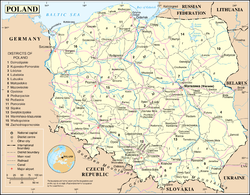
Back Польша Abkhazian Polandia ACE Полшэ ADY Pole Afrikaans Polen ALS ፖላንድ Amharic Poland AMI Polonia AN Polaland ANG पोलैंड ANP
Republic of Poland Rzeczpospolita Polska (Polish) | |
|---|---|
| Anthem: "Mazurek Dąbrowskiego" Mazurek Dąbrowskiego" | |
![Location of Poland (dark green) – on the European continent (green & dark grey) – in the European Union (green) — [Legend]](http://upload.wikimedia.org/wikipedia/commons/thumb/9/9b/EU-Poland.svg/250px-EU-Poland.svg.png) Location of Poland (dark green) – on the European continent (green & dark grey) | |
 | |
| Capital and largest city | Warsaw 52°13′N 21°02′E / 52.217°N 21.033°E |
| Official languages | Polish |
| Spoken languages |
|
| Ethnic groups (2011[1]) | |
| Religion (2011) |
|
| Demonym(s) | |
| Government | Unitary semi-presidential republic |
| Andrzej Duda | |
| Donald Tusk | |
| Legislature | National Assembly |
| Senate | |
| Sejm | |
| Formation | |
| 14 April 966 | |
| 18 April 1025 | |
| 1 July 1569 | |
| 24 October 1795 | |
| 22 July 1807 | |
| 9 June 1815 | |
| 11 November 1918 | |
| 1 September 1939 | |
| 8 April 1945 | |
| 13 September 1989 | |
| 1 May 2004 | |
| Area | |
• Total | 312,678 km2 (120,726 sq mi)[a] (69th) |
• Water (%) | 3.07 |
| Population | |
• 2018 estimate | 38,420,687[2] (34th) |
• Density | 123/km2 (318.6/sq mi) (83rd) |
| GDP (PPP) | 2017 estimate |
• Total | $1,110 trillion[3] (21st) |
• Per capita | $29,250 |
| GDP (nominal) | 2017 estimate |
• Total | $509.955 billion[3] (23rd) |
• Per capita | $13,429 |
| Gini (2014) | medium |
| HDI (2015) | very high · 36th |
| Currency | Polish złoty (PLN) |
| Time zone | UTC+1 (CET) |
• Summer (DST) | UTC+2 (CEST) |
| Driving side | right |
| Calling code | +48 |
| ISO 3166 code | PL |
| Internet TLD | .pl |
Website poland.pl | |
| |
Poland is a country in the eastern region of Central Europe.[8] Its official name is Republic of Poland. It is on the east of Germany (along Oder and Lusatian Neisse). The Czech Republic and Slovakia are to the south, Ukraine and Belarus to the east, and the Baltic Sea, Lithuania, and the Russian exclave Kaliningrad to the north. The total land area of Poland is about 312,679 km2[9] (120,728 mi2), slightly larger than Oman. This makes Poland the 77th largest country[9] in the world with over 38.5 million people. Most Polish people live in large cities, including the capital, Warsaw (Polish: Warszawa), Łódź, Cracow (Polish: Kraków), the second capital of Poland (first was Gniezno), Szczecin, Gdańsk, Wrocław and Poznań.
The word "Poland" was written officially for the first time in 966. In 1569, Poland formed a strong union with Lithuania called the Polish-Lithuanian Commonwealth. At some point in its history, it was the largest state in Europe and became very influential. Eventually, after a slow decline, the Commonwealth collapsed in 1795. Poland regained its independence in 1918 after World War I. In 1921, Poland defeated Soviet Russia in the Polish-Soviet War that started in 1919.
However, Poland lost independence again not long after the beginning of World War II, after suffering a defeat by both the USSR and Nazi Germany. Although the government collapsed, the Polish people fought on by forming the largest and most effective resistance movement in Nazi-occupied Europe. It is most notable for disrupting German supply lines to the Eastern Front of WWII, providing military intelligence to the British, and for saving more Jewish lives in the Holocaust than any other Allied organization or government. After the war, Poland regained "independence" and became a communist country within the Eastern Bloc. The new government was appointed by Joseph Stalin and was under the control of the Soviet Union.
In 1989, Poland ceased being a communist country and became a liberal democracy. Its change of government was the first in a series of events that led to the states of Eastern and Central Europe regaining their independence and the fall of the USSR in 1991. After the democratic consolidation, Poland joined the European Union on 1 May 2004. Poland is also a member of NATO, the United Nations, and the World Trade Organization.
- ↑ "Wyniki Narodowego Spisu Powszechnego Ludności i Mieszkań 2011" [Results of the National Census of Population and Housing 2011] (PDF). Central Statistical Office (in Polish). March 2012. Archived from the original (PDF) on 16 January 2013.
- ↑ "Poland Demographics Profile". Archived from the original on 2020-07-04. Retrieved 2020-05-21.
- ↑ 3.0 3.1 "5. Report for Selected Countries and Subjects". International Monetary Fund. Archived from the original on 24 May 2020. Retrieved 8 May 2017.
- ↑ "GINI Index for Poland". 17 October 2016. Archived from the original on 26 April 2017. Retrieved 25 April 2017.
{{cite journal}}: Cite journal requires|journal=(help) - ↑ "2015 Human Development Report" (PDF). United Nations Development Programme. 2015. Archived (PDF) from the original on 1 May 2020. Retrieved 14 December 2015.
- ↑ Cite error: The named reference
CSO_2008was used but no text was provided for refs named (see the help page). - ↑ Smith, Christian (1996). Disruptive Religion: The Force of Faith in Social-movement Activism. Psychology Press. ISBN 9780415914055. Retrieved 9 September 2013.
- ↑ UN Statistics Division (1 April 2010). "Standard Country and Area Codes Classifications (M49)". United Nations Organization. Archived from the original on 26 December 2018. Retrieved 17 April 2014.
- ↑ 9.0 9.1 "Poland". The World Factbook (2024 ed.). Central Intelligence Agency.

